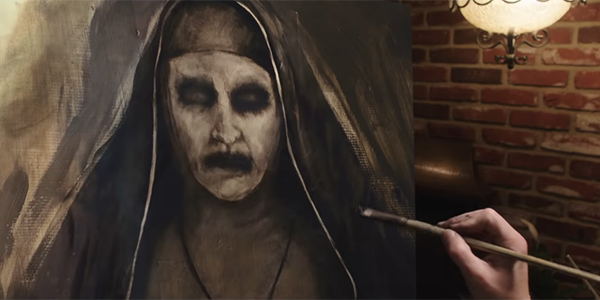When horror meets realism, it can make for a terrifying dive into the supernatural world – into the stuff of nightmares. We are left floating in the chaos that unfolds before us, ignorant to the terror that lies just around the corner. Every sound and movement tells a story, unraveling the mystery of the fine line between good and evil.
Corin Hardy’s “The Nun” is one such plunge, capitalizing on the viewer’s greatest anxieties and deepest fears. When faith, love and purity take a disgusting turn for the worse, the product of this corruption of divinity is a decaying sense of what was and of what could have been in place of the evil that resides unmercifully over a once holy place.
The film begins in a cloistered Romanian abbey, where viewers are first introduced to the unholy power that wields itself over the land and its people. Coming face-to-face with the incarnation of evil itself, a nun jumps from a balcony, committing what seems to be suicide. The Vatican then sets into motion a dangerous investigation led by a troubled priest with a dark past and a young novitiate who has not yet taken her vows.
Immediately, the magnitude of the evil’s presence on the abbey and its surrounding area is apparent. After Frenchie, a cheeky town resident with an apparent aptitude for seducing young women, leads the pair to the abbey, the presence of the evil makes itself known in the form of a nun, blending into its environment much to the dismay and confusion of the other sisters.
Starring Taissa Farmiga as Sister Irene and Demián Bichir as Father Burke, familiar faces to the horror and thriller genres, the film continues as the pair dive deeper into the history of the abbey, soon discovering the real reason behind the nun’s apparent suicide and the origin of the demonic nun, an evil that dates back to the Dark Ages.
Despite resorting to scare tactics typical of most any modern horror film – quick movements, disgusting visual effects and fast-paced action – “The Nun” does seem to offer more than the average run-of-the-mill thriller. Remaining incredibly distinct and detached from the other films within the saga of “The Conjuring”, “The Nun” is a beautiful, albeit terrifying, example of the multifaceted universe that has been created by the directors of each film, emphasizing each individual vision – each individual perception of evil.
In one of the final scenes of the film, Irene faces the nun named Valak, The Marquee of Snakes, in all of its hideous, disgusting glory. Visually, the creature is horrific. Combined with this notion of holy corruption, Valak represents a disturbing sort of blasphemy – how could such an evil reside in such a holy space? As the monster’s long, gnarled fingers tighten around Irene’s white neck, a very clear representation of the battle between God and demon, the emphasis on the destruction of faith erupts in vile mix of blood, water and bodies. Irene is left to fight for her life as Father Burke lay in a crumpled heap and Frenchie attempts to save the young sister.
By the film’s end, Valak’s body withers and returns to the ground, and the convoy are finally able to leave the abbey, now returned to a state of apparent tranquility. As Frenchie leads them out of the town limits, we are made to realize that the evil may not have been completely vanished. The final scene of the film is a flashback to the very first film, “The Conjuring,” to the lecture scene with Lorraine and Ed Warren. We recall the possessed Frenchie, sitting bound in the chair – and as he screams into Lorraine’s face, projecting all the pain, suffering and evil that bubbled out from that Romanian abbey, we are made to realize the breadth of the demon’s influence, beautifully connected across films and universes.







